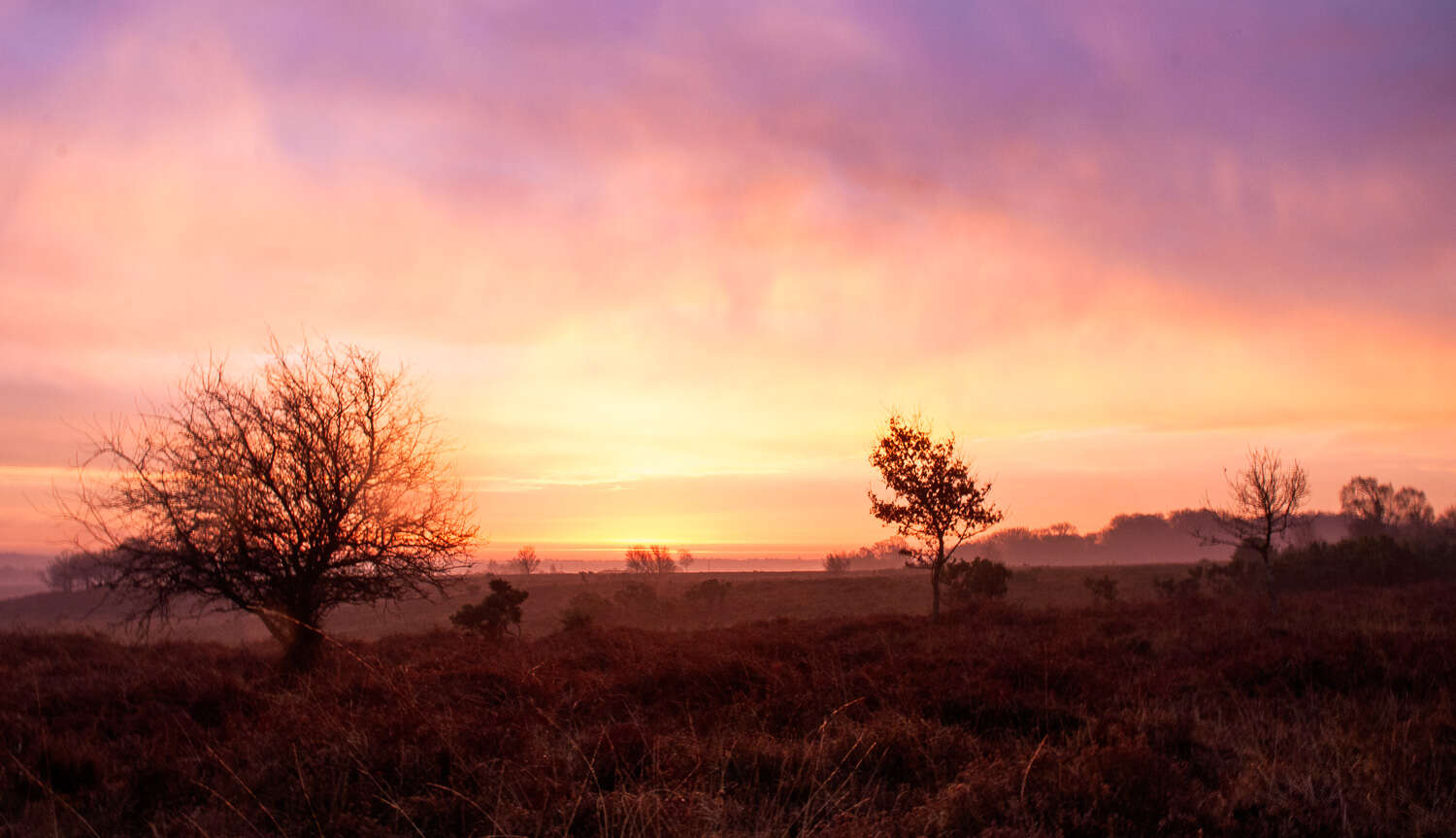Don't forget to subscribe at the new improved home for this blog www.newforestlens.co.uk
All the details and instructions are in the New Forest Lens: A New, More Visual Home For The Blog post
Early morning storm on Yew Tree Heath, New Forest
Perched on a plateau with a good scattering of tree silhouettes and ponds to enhance the composition, the panoramic view stretching east over Southampton Water from Yew Tree Heath forms an ideal staging for sunrise.
Through a distant veil of broken clouds, the sun breaches the horizon, painting the sky amethyst, rose and saffron - shepherd's warning from weather folklore - a harbinger of storms to come, and indeed, barreling overhead out of the west, an unexpected storm looms, the dark shapes of dense rain clouds outlined by the sunrise's glow. Unexpected and unnoticed, raindrops splatter the lens, blurring and softening elements of the image, whilst my inexplicable selection of a crazily small and diffraction-inducing f16 aperture compounds the previously unnoticed less-than-stellar optics of this cheap zoom kit lens to create shockingly poor edge-of-field sharpness.
I cursed myself for not noticing the raindrops, not wiping the lens and not selecting a more middling f8 aperture. Once viewed on the fifteen-inch laptop screen, what looked tantalisingly promising on the tiny two-inch camera screen morphed into a distorted smear, hinting at, perhaps, a poor-quality knock-off copy of a Lensbaby, or maybe an original Lomo 35mm camera, rather than a decent SLR lens. Fortuitously, though, taken together, the errors synthesised into an evocation of a tempestuous Turneresque landscape, where the whole is, unintentionally, greater than the sum of its parts.
So, despite the omnishambles of my contribution to the mechanics of the image capture, by processing rather than erasing the photo, a serendipitously satisfying result emerged, only possible because, in that moment, the original scene really was a spectacular 'painting of light'; Lightroom can't make a silk purse out of a sow's ear, after all. I did, however, go on to replace that lens with a higher-quality prime wide-angle lens, and I'm now much more circumspect about using f16 for landscapes; you learn from your mistakes.
Photo details - Nikon D80, Nikkor 18-70mm@18mm (23mm equiv.), f16 0.5sec, ISO100, processed in Lightroom MacOS (basic light settings only)
Through a distant veil of broken clouds, the sun breaches the horizon, painting the sky amethyst, rose and saffron - shepherd's warning from weather folklore - a harbinger of storms to come, and indeed, barreling overhead out of the west, an unexpected storm looms, the dark shapes of dense rain clouds outlined by the sunrise's glow. Unexpected and unnoticed, raindrops splatter the lens, blurring and softening elements of the image, whilst my inexplicable selection of a crazily small and diffraction-inducing f16 aperture compounds the previously unnoticed less-than-stellar optics of this cheap zoom kit lens to create shockingly poor edge-of-field sharpness.
I cursed myself for not noticing the raindrops, not wiping the lens and not selecting a more middling f8 aperture. Once viewed on the fifteen-inch laptop screen, what looked tantalisingly promising on the tiny two-inch camera screen morphed into a distorted smear, hinting at, perhaps, a poor-quality knock-off copy of a Lensbaby, or maybe an original Lomo 35mm camera, rather than a decent SLR lens. Fortuitously, though, taken together, the errors synthesised into an evocation of a tempestuous Turneresque landscape, where the whole is, unintentionally, greater than the sum of its parts.
So, despite the omnishambles of my contribution to the mechanics of the image capture, by processing rather than erasing the photo, a serendipitously satisfying result emerged, only possible because, in that moment, the original scene really was a spectacular 'painting of light'; Lightroom can't make a silk purse out of a sow's ear, after all. I did, however, go on to replace that lens with a higher-quality prime wide-angle lens, and I'm now much more circumspect about using f16 for landscapes; you learn from your mistakes.
Photo details - Nikon D80, Nikkor 18-70mm@18mm (23mm equiv.), f16 0.5sec, ISO100, processed in Lightroom MacOS (basic light settings only)
